For most of January and early February the weather was amazing, pushing into the mid-70’s during the day, and convincing both us, and the garden, that we were in for an early spring. This week though it’s wet, and everything here is mud and puddles. According to our weather station this current storm has already dumped 5.6 inches of rain, and there’s more on the way.
Our Dutch Master daffodils that started blooming just over a week ago are now looking rather sad.
However, our dry spell was too dry for this early in the season, and we’d even had to resort to watering a few things, especially our new fruit trees, so we’re grateful for the rain, and so is the garden. In between this storm’s deluges I went out to check on how things were doing.
In the vegetable garden the beets are still brimming.
The new foliage on the red beets is beautiful, but this variety (Red Ace) will be replaced with Bull’s Blood this spring, so our beet ‘greens’ will be an even more vibrant burgundy red.
The rhubarb we planted this winter is really starting to take off, and I can’t wait for that first strawberry-rhubarb pie.
Speaking of strawberries.
The Tatsoi we planted in late fall is still going strong, but the recent warm weather confused it, and much of it is now starting to bolt, so this crop will soon be replaced with a fresh spring crop.
The Pak Choi was similarly affected by the heat, but despite freezing numerous times, both of these greens have been great throughout winter. Stir-fry anyone?
Completely unaffected by freezing, or persistent winter heatwaves, the Red Russian winter kale is again performing phenomenally this winter.
The Lacinato kale has been doing reasonably well too.
We’ll try to sneak in a spring crop of both types of kale before the weather gets too warm.
The red-veined sorrel hasn’t quit all winter, which will no doubt please the hens as they love to sneak in a nibble as they wander by the garden.
The last of our hybrid Blue Wind broccoli is heading up. The next broccoli crop will be the heirloom Calabrese.
Despite an outbreak of vandalous voles this winter (more on that in a moment), the French Breakfast radishes are hanging in there.
The peas, both the shelling peas ‘Progress #9’, and the snow peas ‘Oregon Sugar Pod II’…not so lucky. In fact, the voles completely wiped out a total of 200 (yes TWO HUNDRED) seedling pea plants. There will be some vole abatement implemented in the gardens shortly. Suddenly our gophers don’t look bad.
In the herb garden, we weren’t sure the sage would recover from the frost this winter, but it’s bounced back.
Throughout the gardens, both varieties of rosemary we have planted are blooming, delighting the bees on the warmer sunnier days.
We’d planted this upright rosemary last year. Then last summer, feeling frugal, I divided a $20 flat of prostrate rosemary into 40 separate plants, and grew them to a 1 gallon container size myself. This winter we planted them all out on the upper slope of the orchard, both to help stabilize the soil, and to give our Mason Bees a dependable source of winter nectar.
I’m amazed at how well these young plants are blooming already, and can’t wait to see them fill in.
Speaking of blooms, I’m especially excited about our native Ribes sanguineum planted behind the raised vegetable beds. I almost killed this plant while it was sitting in a pot a little too long waiting to be transplanted. Last year it didn’t do much at all, but this winter it’s blooming for the first time!
Our other native Ribes, Ribes viburnifolium, has settled in too. Clearly happy beneath some oaks it is blooming its heart out this winter.
This ribes species sets rootlets along its branches in wet weather where the branches touch the ground, so taking cuttings this spring should be easy.
Our young Meyer lemon tree surprised us with a decent crop this year.
Our southern highbush blueberries are starting to bloom.
Just in case you thought we were done with voles, they’re running amok in the orchard too. This is why we fitted every fruit tree with gopher and vole guards when we planted them.

I caught this vole popping out of a hole right under the gopher guard around the Golden Delicious apple (click image to enlarge)
There’s more in the orchard than ravenous rodents though. By early February the fruit trees were convinced that spring had arrived. The Flavor Delight aprium was the first to bloom, and has since been followed by the plums, like this Satsuma…
…and even last year’s favorite with the deer, the Frost peach, is blooming!
Although I sowed them late, our native wildflower seeds are grateful that the rainy season isn’t over yet. Our California poppies (Eschscholzia californica) are pushing all over the orchard.

The California poppies have sprouted, but it's a constant battle to stop the weeds from smothering them
The Goldfields (Lasthenia glabrata) are sprouting everywhere too.
Hopefully, if they don’t all get washed down the slope, we’ll have some lovely spring blooms in store for us by mid-spring.
When these storms finally stop, all this extra water will no doubt push a second flush weeds amidst the wildflowers, so we’ll be busy keeping those down this spring while the wildflowers establish themselves.
With our changeable weather, there’s not much food growing here at the moment. Trapped inside during the rainy weather though, we’ve been busy organizing for spring, and now have lots of seed trays full of this season’s promise, and hopefully it won’t be long before the gardens are brimming. There are only 30 days left until the official start of spring!

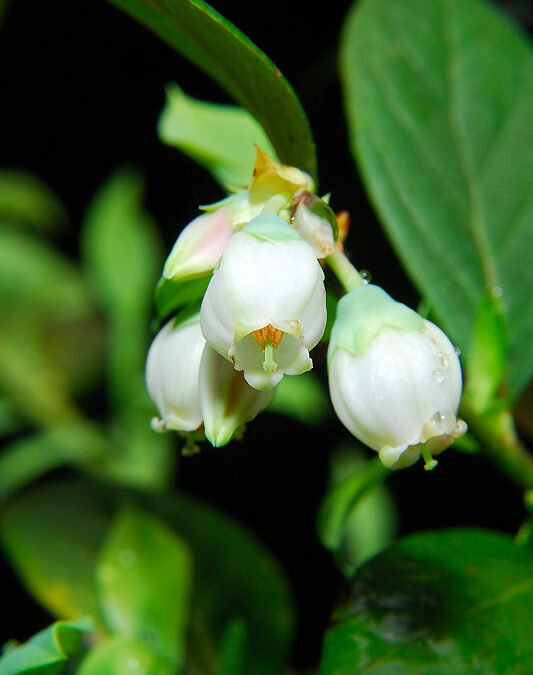
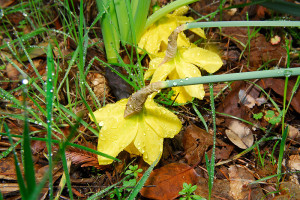

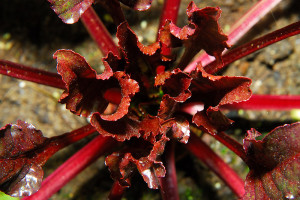
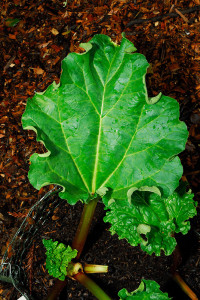
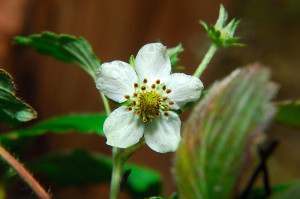
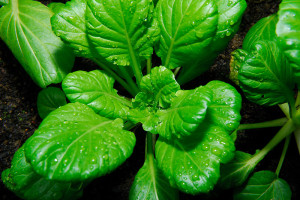
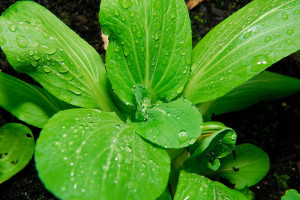
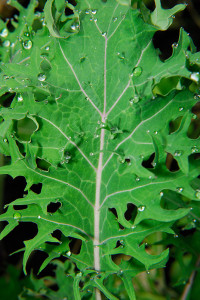
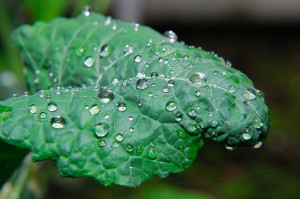
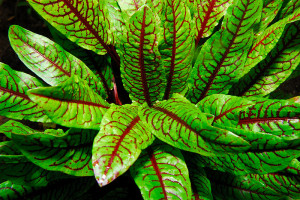
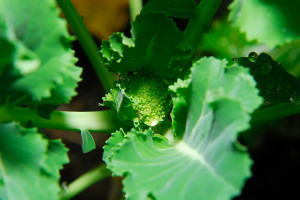
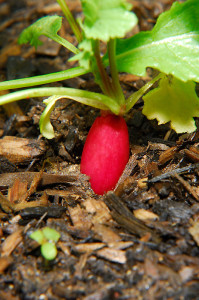

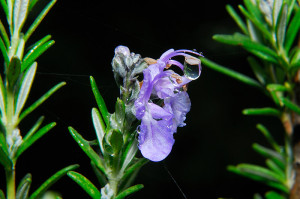



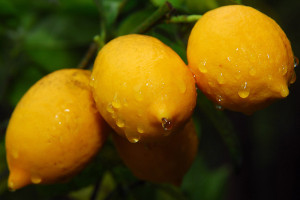
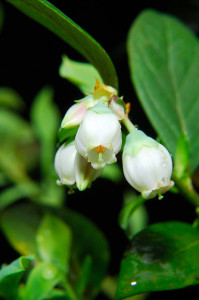
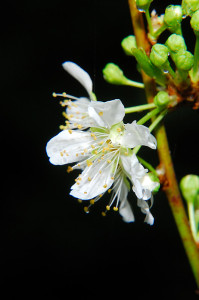
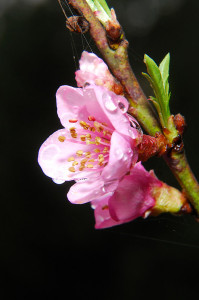
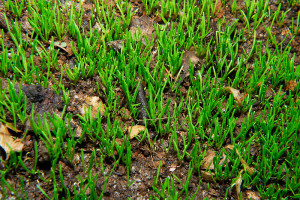







Thanks for the update – it’s nice to see green and blooms in somebody’s garden! 😀
I feel your pain with the voles. They were terrible here for a couple of years, but this past year or so we haven’t had any damage. I am giving credit to our feral cats. They won’t touch the moles though.
That red veined sorrel is lovely. Is it as tasty as the plain leaf French kind? To humans, that is!
I wish we could recruit some cats to help with our vole problem, but we’ll have to be more creative. Coyotes in this neighborhood don’t permit loose cats to last very long 🙁
I really like the red-veined sorrel. Young leaves are quite mild, so I prefer not to eat it alone, but mixed in with arugula, or other salad greens, it definitely ups the pizazz quotient! The mature leaves get a little tough, so we pass those on to the hens 😉
I can’t believe how far ahead your garden is! Seeing those early veggies makes me excited since we’ll be able to grow more of those types of things once we get our raised beds in. I’m going to look for the beets you plan to grow this fall. The blueberry bushes here are really getting close to leafing out. Hope those voles move on.
I hope those voles move on too! Bull’s Blood beets are quite common, if you can’t find them, we picked ours up through Baker Creek Seeds:
http://rareseeds.com/bull-s-blood-beet.html
It’s fun to see how different your season is than ours (daffies and blueberries blooming at once!). Your garden looks vibrant and hopeful.
Hmmm…I never really thought about daffodils and blueberries not blooming together 😛 I’m guessing your blueberries bloom after your daffs?
Oh my – I think I’ve got beet envy – what gorgeous foliage! I love the idea of poppies in the orchard…
As for the daffodils – they may spring back up. They are built for spring storms…
Lovely post…now I’m all excited about spring and want to go out in my garden but it’s still raining…which is not a bad thing.
I know, this rain is becoming insufferable. I got spoiled with the beautiful Bay Area weather earlier this winter. Our poor turkeys and chickens are not amused with all the water running everywhere at the moment, and neither am I. We need the rain, but I’d like a break so I can get out and do some weed bashing before the weeds smother the wildflowers!
Bad news about the voles and your peas. We are planting peas on Sunday, finally. Got to try the Red Russian winter kale, buy it at the local farmers market and enjoy eating it.
Good luck with your peas Randy. I never did replant our crop, I was so deflated after the voles absconded with the lot. I’m going to try again though as soon as this rain stops, but I may need a mouse-trap next to every pea plant! 😛
My mouth was watering for all your tasty vegetables. I too love beets. Yum. And your critters…that vole had nerve to make an appearance and pose for the camera.
Unfortunately, that day, he wasn’t alone. The first vole shot across my boot while I was planting some Coyote Mint on the slope. As the sun swung around into the orchard, every once in a while I’d see movement out of the corner of my eye. I stopped, and stood there for a moment, and saw about a half dozen voles shooting across the slope from one vole hole to the next (they hate to be out in the open, which makes them hard to trap). I swear, it was like watching little furry bullets shooting across the slope. So I stalked this brazen little rodent by the apple tree. I have about 50 photos of him popping his head out of that hole. The only good thing is the gopher and vole guards seem to be working!
A hillside of prostrate rosemary! How wonderful for you and the bees! But I am sorry about your peas! I’m no fan of voles; those critters once wiped out almost all the hostas in my lady garden.
I’m so excited about the rosemary, and can’t wait for it to fill in. It has to be better than the invasive brome and hedge parsley that pops up every spring. The bees go bonkers for it too, almost as much as the lavender!
Dear Clare, What an interesting selection of vegetables you have been growing. I have gradually become an afficionado for Kale [eating it, not growing it] and yours looks particularly good.
I used to shun kale, but honestly, now I can’t imagine not growing it. We use it in a lot of winter soups, and even on winter pizzas!
You have such a variety and it all looks so healthy. I love that red veined sorrel and the red beets.
We’ve had too much rain here combined with heat. You can have too much of both. My vege patch is quite sad at the moment so it’s nice to see some healthy veges.
The red-veined sorrel is very easy to grow too, although the aphids did develop quite an attraction to it last summer. I suppose we could use it as an aphid trap crop though, which would make it probably one of the prettiest trap crops I’ve seen!
Loved the photo of the radish peeping out of ground and the blueberry blooms. You have so much life bursting out in your garden. Yay for an early spring!
So much for an early spring! They’re predicting the first sea level snowfall in the San Francisco Bay Area this weekend since 1976! :O
What an amazing variety of veggies you have in your garden! I love the look of the red-veined sorrel, which is actually quite ornamental. My curiosity was piqued by your mention of voles as a garden pest. You name it, we’ve got ’em here: gophers, squirrels, rabbit, deer mice, etc…but now I’m wondering about voles. Seems like the use of gopher cages would also protect against these rodents. Sheesh! It’s a never-ending battle, isn’t it?
The gopher wire has definitely slowed the incursion of voles into the root zones of our fruit trees, but at the moment our new Spitzenburg apple tree is surrounded with vole holes. It seems everything wants to eat our plants, and what doesn’t want to eat the plants…wants to eat our chickens! 😛
Clare, your garden is so healthy! I love the beets – they’re a favorite of Lola’s. Although when she drips red juice on her plumage, it scares me…I always mistake it for blood!
BTW…I wanted to let you know that I’m giving you a blogger award. I’ve posted about it in my latest post, “A Gift”, and linked to your blog. I hope you’ll accept…I think you definitely deserve it!
Oh, maybe in the interests of not having Lola look like she’s been shot, you should try the golden beets? If she likes those, which I think are just as tasty, at least they won’t stain her lovely white feathers as badly! Thank you for award too Kimberly. I will acknowledge it, but it may not be until early next week 🙂
Clare that red veined sorrel is so ornamental it would look lovely in a container with bedding plants. You have so much to look forward to in your spring garden. I clicked on the photo to see that vole and it surprised me at how big a critter he is. All the wildlife in your area Clare certainly keeps you on your toes. The word will have to get out that Curbstone Valley is like Fort Knox.
The voles are quite sizable, they look like tubby rounded mice with short tails, and ours seem to be particularly well fed! I don’t mind the wildlife here, I just think our balance is a little off, especially in the orchard and vegetable garden at the moment. Now that it’s fenced, the coyotes and bobcats can’t get to the voles and gophers, and seem instead to be preoccupying themselves with our poultry while the voles run amok!
Wow, you are so ahead of us, I’d say at one full 31-day month ahead. Thanks for the sneak preview! Don’t forget to spray those peach trees with Liquid Fence or Deer Away!
Ah, this year, if all goes well, the fence should keep our dastardly deer off the peach trees! 😉
Glad to see your Ribes sanguineum survived. They are really beautiful plants with or without flowers. Birds always seem to eat my peas. I’ve had issues getting them to survive past seedling stage for several years now, but losing 200 is a massacre. The goldfields will look great like that. They are much more interesting when there are a lot of them.
I’m hoping the Goldfields will look impressive in a swath. I wasn’t sure whether to mix our wildflower seeds together, or plant them in individual drifts. I opted for drifts, and figure they’ll blend themselves together at the edges over time. I’m so ready for spring though, I want to see them bloom!
Wow! I’m in awe of how everything is coming along; even more in awe of how you’ve overcome all the ‘animal & insect’ garden attacks!
It’s always a treat to stop by and see what’s going on… 🙂
I do have days where I feel like we’re living in the wild wild west! 😉 Sometimes I’m amazed anything grows here!
Dear Clare, Wow! I must confess to being so jealous of your growing season and bounty of veggies to pick all winter!! Your greens look so delicious. It is exciting to see your blooming apples and all the young shoots popping up. Beautiful photos of your incredible gardens. The rosemary will be wonderful for your bees. I am sure your garden is grateful for all the rain.
I’ve got to deal with ants and scale on my lovely old lemon tree. What do you suggest? We installed some homemade tanglefoot by making an inside out collar of painters tape. I’ve been washing leaves, but that’s insanely time consuming.
Sorry Lisa, I missed this when you posted it. I had a horrendous problem with ants and scale on a Eureka lemon in the Central Valley. Until I got the ants under control, the scale just kept coming. I was surprised to learn that although the soft-bodied scale itself is vulnerable to a number of garden predators, the ants actually protect and defend them, and will fight off predators! They mean business when they’re ranching scale and aphids I guess. Get the ants under control, and nature will help with the scale (hopefully).
I’ve had a little scale on this Meyer too, and we’ve used the Tanglefoot tree-wrap paper, and slap Tanglefoot on it (we have both on hand for the orchard trees anyway). You have to recheck it every week, as when the dead bodies pile up on the Tanglefoot, their ant sisters just walk across the bridge of dead ants, so it does need refreshing. While the ants are at bay, you can use a directed stream of horticultural oil on the scale themselves to smother them and knock the population down. You can make your own with water, dish soap and vegetable oil. There are some recipes online, but you can mix 1 Tbsp of Ivory dish soap, to one cup of Vegetable oil. Store that in a Mason jar, and then add a 1-2 Tbsp of that mix to 1 cup of lukewarm water, and spray away. Good luck! I hate scale…they’re tenacious beasties!
Thanks Clare.
I’ve had so much to deal with that I neglected the scale issue. Honestly, the tree churns out so many lemons that it’s a bit crazy. But I’d be happier if it weren’t fighting the scale.
Is Tanglefoot a problem around cats? When I lived on a dairy farm, the cats would get wrapped up in flypaper, and the songbirds would get stuck into the huge rolls of flypaper that they used in the calf barn. The cat issue was funny. I just cut them out of the flypaper, and the poor cats looked like a five year old gave them a haircut. The bird thing was tragic.
Wow! quite a report, I enjoyed it. I’m growing catalina current from cuttings that sprouted in a bucket of water before I planted them. not forethought, just serendipity: some prunings, some rain. They seem to be taking hold well. I’m glad your wildflower seedlings came up – good to know about the goldfields; sow thinly. I might try some.